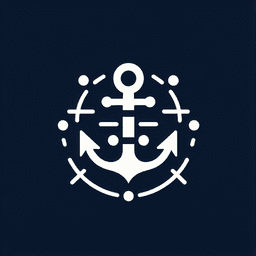
Anchoring Scope: Definition and Examples
January 16, 2025
Anchoring Scope
Anchoring scope is a critical concept in maritime navigation, referring to the ratio of the length of anchor rode (chain or rope) deployed to the depth of the water. This ratio is essential for ensuring that an anchor holds securely in place, providing stability to the vessel.
For sailors, understanding and calculating the correct anchoring scope is vital. A common rule of thumb is to use a scope of 7:1, meaning for every foot of water depth, seven feet of rode should be let out. This ratio can vary based on conditions such as weather, sea state, and the type of seabed.
In calm conditions, a scope of 5:1 might suffice, while in rougher seas, a scope of 10:1 or more may be necessary to maintain a secure hold. The type of anchor and the vessel's size also influence the appropriate scope.
Proper anchoring scope ensures that the anchor lies flat on the seabed, maximizing its holding power and minimizing the risk of dragging. This is crucial for the safety of the vessel and its crew, especially in crowded anchorages or adverse weather conditions.
Mariners should always consider the tidal range and potential changes in water depth when calculating the anchoring scope, adjusting as necessary to maintain security and stability.
Understanding Anchoring Scope in Maritime Context
Anchoring scope is a crucial concept in maritime operations, referring to the ratio of the length of anchor rode (line or chain) to the depth of the water. This ratio is vital for ensuring that a vessel remains securely anchored, especially in varying weather conditions.
Why is Anchoring Scope Important?
The anchoring scope determines the holding power of the anchor. A longer scope allows the anchor to lie flat on the seabed, increasing its holding power. This is particularly important in rough seas or strong currents, where a short scope might cause the anchor to drag.
How to Calculate Anchoring Scope
To calculate the anchoring scope, divide the length of the anchor rode by the depth of the water plus the height of the bow above the waterline. A common recommendation is a scope of 7:1 in calm conditions, meaning seven feet of rode for every foot of water depth.
Factors Affecting Anchoring Scope
- Weather Conditions: Strong winds and currents require a longer scope for better holding.
- Seabed Type: Different seabeds (sand, mud, rock) affect how well an anchor holds.
- Anchor Type: Some anchors are designed to hold better in specific conditions.
Common Questions About Anchoring Scope
Here are some frequently asked questions that are relevant to maritime users:
- What is the best anchoring scope for stormy weather? In stormy weather, a scope of 10:1 or more is recommended to ensure maximum holding power.
- Can anchoring scope affect fuel efficiency? While anchoring scope itself doesn't affect fuel efficiency, improper anchoring can lead to drifting, which may require engine use to reposition, thus affecting fuel consumption.
- How does anchoring scope differ for different vessel sizes? Larger vessels may require a different scope due to their weight and the forces acting upon them, but the basic principle of a longer scope providing better holding remains the same.




